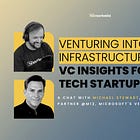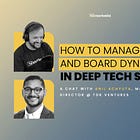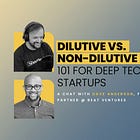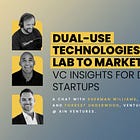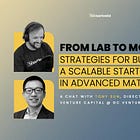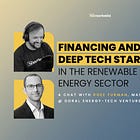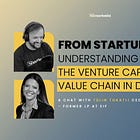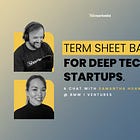Deep Tech Catalyst - Special Edition, Part II
50 Episodes, One Year Later: A Unique Collective Intelligence on Best Practices for Building Investable Deep Tech Startups.
Dear Community,
We are extremely excited to celebrate the milestone of the 50th episode of Deep Tech Catalyst, a collection of unique strategies, tactics, and best practices for building investable deep tech startups.
It’s the product of a 1-year process involving the wisdom of global VC, CVC, and deep tech experts, access to exclusive and unique information, and constant detailed research to define best practices by leveraging a unique collective intelligence.
When we first set out to create Deep Tech Catalyst, we asked a simple yet profound observation: many scientifically intensive entrepreneurial projects don’t align with traditional VC models. This disconnect hinders the creation of “investable startups,” ultimately slowing the journey of breakthrough innovations into the real world.
Our goal was to deliver genuine foresight.
Today, it has become a unique global intellectual hub—attracting over 12,000 visits each month from founders, scientists, and investors who actively engage with its insights and resources.
Last but not least, thank you so much, dear guests, for making this possible, for being a vital part of this journey, and for sharing your insights and inspiration!
Of course, the journey doesn’t end here, so stay tuned! 🚀
💥 AI is Reshaping the Way Humans Work with Machines
The technology that is running AI today to create the applications that are generating revenue is largely built on a foundation that was designed for a different era of technology, a different kind of compute substrate, a different architecture, even for the applications.
And that's fine. That's fine during the period of time when most of the demand we're seeing is kind of general compute and AI is a piece of that. It could be like 5%, it could be 10%, it could be whatever percent you want to imagine, but growing.
Now, as we've turned this corner to see what the potential could be, the disruptive potential, this is a lot bigger than one new technology disrupting an equilibrium. This is more about reshaping how humans work with machines.
- Michael Stewart, Managing Partner at M12, Microsoft's Venture Capital Fund
🙏🏻 What Startup Culture Means
Culture is not something you write on a wall, put some slogans and stuff like that. Culture is really about what you are going to do when nobody's watching. That is the key part. [...] It has to come from the top down—from the CEO level, more often than not, from the CEO/founder.
- Anil Achyuta, Managing Director at TDK Ventures
📈 The Strategic Use of SAFE Notes
If you were to raise a price round from the very beginning, when your company is not worth a whole lot, then any money that you bring in would be highly dilutive. So what a SAFE note allows you to do is basically postpone pricing the company until you raise that price round.
- Dave Anderson, Founding General Partner at Beat Ventures
🔍 Framing the Dual-Use Technology Opportunity
If you use proxies for what [the DIME framework] means and look at the amount of spend that can come in each of those sectors, the economic sector, the last one, which is a proxy for the commercial sector, is the biggest by far. It's actually bigger than the other three combined.
- Sherman Williams, Managing Partner at AIN Ventures
🤖 Building Scalable Robotics Startups
Can this be scaled up? Is this process going to be able to be scaled up? I would always keep an eye on that and then note that down and say: "Hey, I'm not sure this could be scaled up the way we're going to build these things". [...] That is an area that you want to take note of and then make sure that that could be addressed. Because if you just go completely haywire or ad-hoc and say, I'm not worried about anything about the modularity, scalability, then you might come to a point where you'll hit a wall.
- Karthee Madasamy, Founder and Managing Partner at MFV Partners
🤝 Leveraging the Power of Customer Interviews in Advanced Materials
When you're doing customer interviews, don't just treat your customer as a customer; also treat them as a friend, as a potential advisor. Ask them about the supply chain. Ask who the decision-makers are, who the actual paying customers are, and how the decision is being made. Try to embed some of these questions in your customer interview, as they will help a lot.
- Tony Sun, Director of Corporate Venture Capital at GC Ventures
📊 How to Approach Value and Price in B2B
Building a relationship [with potential customers] will help you get to a point where you can price it, which makes sense for you because you need to know your own costs and kind of price it in a way that makes sense. But also you're still creating value for the customer. And I think that can only come from really good customer relationships and spending a long time with them, which is really time intensive, but it's what it takes.
- Chloë Payne, Principal at Ponderosa Ventures
🚀 Competing with Evolving Technology
How is what I'm trying to do improving on the state of the art? And that can be a little bit challenging because you may not always know what state of the art is, but in your best estimate, you know, how much is this going to improve whatever I'm trying to improve? And what's the timeline for when this could be commercial? Because you have to realize that you're not competing with today's technology. You're competing with where today's technology is going to be when you're commercialized.
- Robert Ashcraft, Investment Director at Samsung Ventures

How to Approach the Semiconductor Industry: VC Insights for Deep Tech Startups | Deep Tech Catalyst
🚦 Standout Points for VCs in Pre-seed Fundraising
What I look for in signal in terms of that actual market pull is the amount of resources somebody has dedicated to working with you. And that can come in many forms, right? At a pre-seed stage, it can be small customers trying to knock you down to give you orders that you can't fill. It can be large customers putting together land, water, and power resources to actually try to work together […] the amount of resources they're dedicating to working with you and how you can show your work in showing the amount of resources that they put together just to talk to you, to think about working with you, to put in concrete steps to that, that says a lot to a pre-seed investor like me.
- Dee Zheng, Managing Director at Orca Climate Fund
🎯 Aligning Engineering and Business Goals in the Energy Sector
Sometimes in our industry where we meet a lot of innovators and scientists, they speak about science. They speak about scaling up from TRL 3 at the lab to TRL 6, which is great. You need to go in this direction. But at the same time, don't forget that scaling up alone will not be sufficient or will not be enough for investors. [...] How do you de-risk from a commercial perspective? Try to bring as many proof points as you can get from the industry that your product has a real demand or a real need for your product. And how can you do it? For example, you can think about design partnerships. You can think about joint development agreements if you're developing a new chemistry or something like that. You can think about future look into actual projects, like creating a pipeline or conditional orders to your technology.
- Roee Furman, Managing Director at Doral Energy-Tech Ventures
✅ The Role of Offtake Agreements in Early-Stage Market Validation
One that we see quite frequently in Deep Tech or in sustainability and climate where I work a lot is offtake agreements. And this is a contract between a buyer and seller, an arrangement for purchasing something. And what's great about these is that they provide market validation. You're typically setting a price for something. In some cases, if it's a binding agreement, there's guaranteed revenue. It's legally binding. And these agreements, I think, enhance the credibility of a relationship. So when you go to raise financing, it unlocks other types of financing, maybe less risk-averse capital. If you have a binding offtake agreement, it's really helpful.
- Dennis Clark, Investment Director at Zeon Ventures
🍰 The Venture Capital Value Chain
I see the VC value chain as a big pyramid. And on top sit the mandators, those that are allocating the big pot of money. And down there sit the public investors, like the fund of funds. [...] Then venture capital funds and private equity funds, which in turn allocate this money to the startups. So in this dynamic, and I think in this ecosystem, it's always, yeah, about capital fundraising. [...] Everything in the dynamic is based on generating value, bringing something to the table, and creating value for the ones that are on the top: the investors.
- Tülin Tokatli, CEO at Pitch Me First - Former LP at EIF
📃 Term Sheet 101
Before actually accepting a term sheet, you have to run the numbers on your cap table and determine your ownership.
- Samantha Huang, Principal at BMW i Ventures







